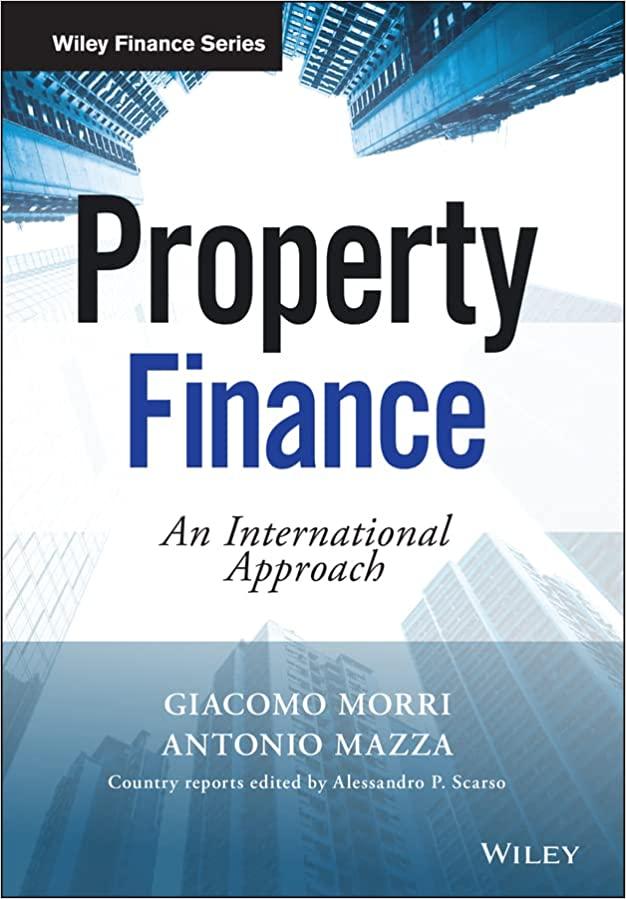Question
THE SITUATION: Your client, Lender, is developing a proposal to provide financing to Owner for the purchase of a commercial property. Owner requires an $900,000
THE SITUATION:
Your client, Lender, is developing a proposal to provide financing to Owner for the purchase of a commercial property. Owner requires an $900,000 loan to make the deal work. Market 1st mortgage rates for similar projects are 5.40%. A standard CPFAM at this rate results in a Debt Service amount producing a Debt Coverage Ratio (DCR) very close to 1.0, which is unacceptably low for both Lender and Owner. At the same time, Lender likes the growth potential for the property, and therefore wants to put together an offer to Owner using a mortgage that includes Equity Participation cash flows. The fundamentals of the deal at the current time, using a standard CPFAM are as follows:
Purchase Price $1,200,000
Mortgage Amount $900,000
Nominal Annual Mort. Rate 5.4%
Loan Term 20 yrs.
Year One NOI $74,000
NOI Annual Increase $3,000
NOI Caprate .0617
Investment Horizon 5 yrs.
The loan will be prepaid at the end of Year 5. The going-out caprate is expected to be the same as the going-in caprate of .0617.
THE PROBLEM:
The problem with the standard CPFAM is that the Debt Coverage Ratio (DCR) is too low. Lender wants to correct that problem by structuring a proposal for an equity participation mortgage (epm) using a Base Mortgage at a below market rate, thus increasing the DCR. Your job is to structure a proposal that will be acceptable to Lender, and also to Owner.
LENDERS GUIDELINES:
1) Lender is looking for a DCR in the 1.1-1.3 range, but she will consider accepting a DCR slightly below 1.1 in Year One if it is helpful.
2) Lender realizes that she will be switching future cash flows from the base mortgage debt service, to some claim on cash flows that are less predictable. As a result, she is looking for an Internal Rate of Return (IRR) greater than 5.4%. She feels that a figure in the 7.0% range would be appropriate.
3) Lender wants to have a Priority claim on current cash flows subordinate only to required Debt Service (DS), such that, if the priority is collected, she will have a total annual Cash Flow from DS and the Priority equal to or greater than DS would have been under the standard CPFAM.
4) Lender wants the Base Mortgage to be a 20 year CPFAM.
OWNERS OBJECTIVES:
1) Owners Equity investors are anxious to receive some current return on equity (CROE) as soon as possible. They are expecting to see a CROE in the 3.0% range, but are willing to settle for less in the early years, provided that this return is greater than zero in all years.
2) Owner must have a $900,000 loan; he has only $300,000 of Equity available.
YOUR OBJECTIVE:
Its your job to put together a proposal that will be favorable for Lender, but will contain features that will make it acceptable to Owner. Remember, its easy to put together a sweetheart deal for Lender, but it will be meaningless unless the deal is acceptable to Owner.
YOUR GUIDELINES:
You may propose any structure for the distribution of cash flows that you want, subject to the following limitations:
1) The Base Mortgage must be a 20 year CPFAM for $900,000.
2) The Purchase Price is $1,200,000.
3) The Year One NOI and the annual NOI increase cannot change.
4) The investment is a five year investment; the Mortgage will be prepaid at the end of Year 5. At that time, the building will be sold, or, if the capital gain is included in the Cash Flow distribution structure and the building is not sold, the capital gain will be computed.
5) The going-in caprate and the going-out caprate at the end of Year 5 are assumed to be the same.
Remember that Owner is a valuable client. No matter how sweet the deal may be for Lender, it means nothing unless Owner also finds it to be appealing. Do not be insensitive to the needs of Owner.
ASSIGNMENTS:
- SPREADSHEET ONE: Use an Excel spreadsheet to present a Statement of Cash Flows for each year in this investment under the Standard 5.4% CPFAM, including the expected IRR. This spreadsheet must be structured in simulation mode, so that all cash flows and the IRR will change automatically when any of the Assumptions are changed. To help you, I will post a pdf version of this spreadsheet that will contain the correct Cash Flows and the IRR of 5.32%. You may use my format in preparing Spreadsheet One, or another format that makes the Cash Flows equally clear.
Step by Step Solution
There are 3 Steps involved in it
Step: 1

Get Instant Access to Expert-Tailored Solutions
See step-by-step solutions with expert insights and AI powered tools for academic success
Step: 2

Step: 3

Ace Your Homework with AI
Get the answers you need in no time with our AI-driven, step-by-step assistance
Get Started


